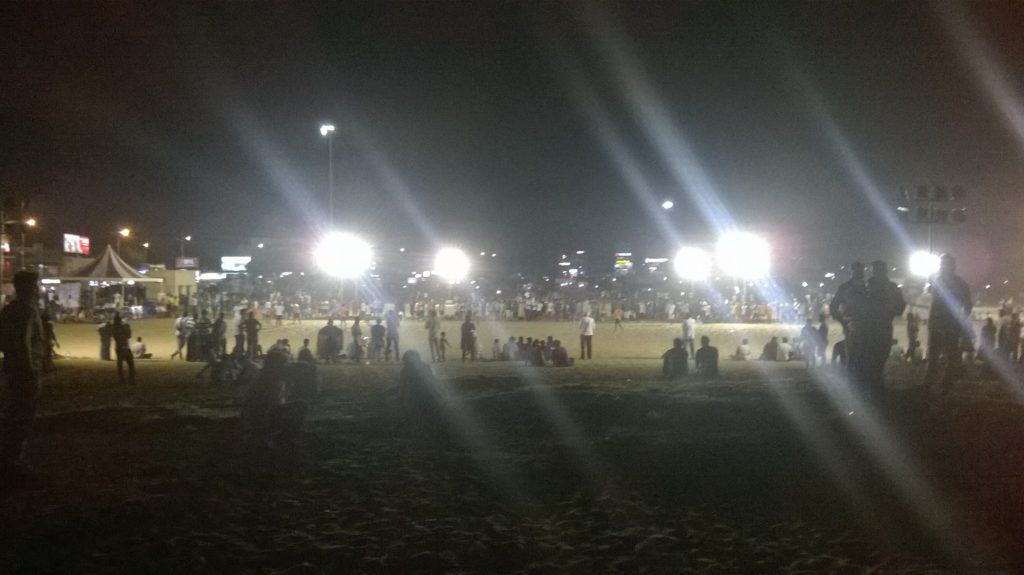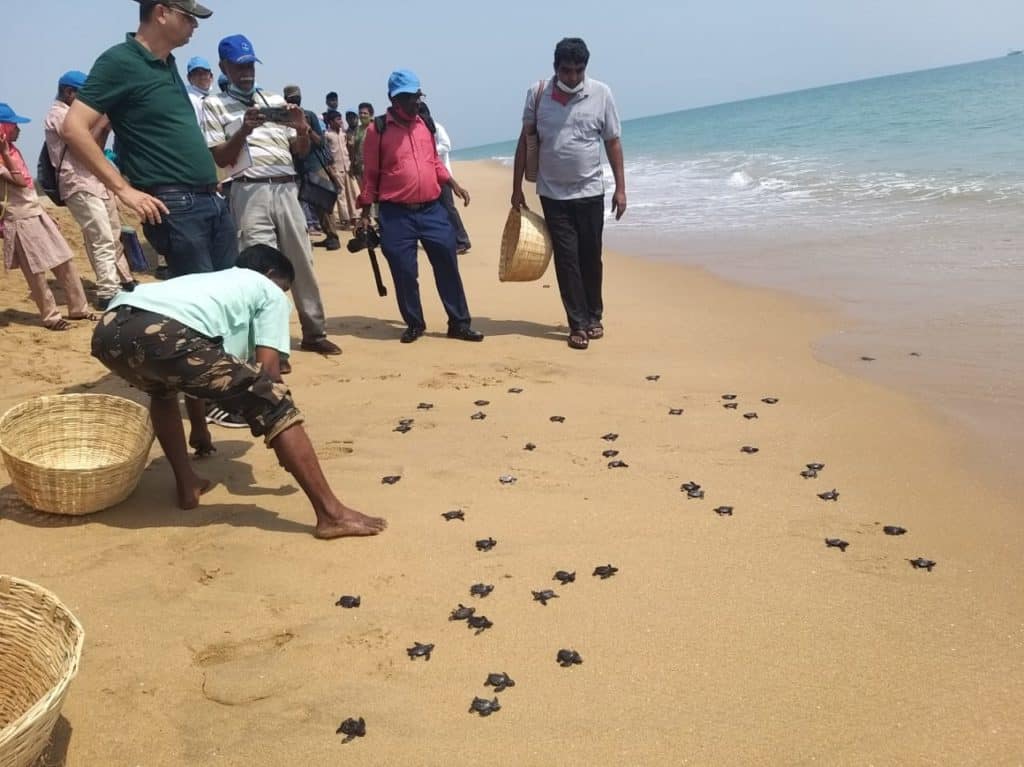A little known fact about Chennai that came to light through a 9th Century relic found in Ambur was that present day Adyar and adjoining Adyar estuary areas were once known as Amaiyur (amai meaning turtle in Tamil). In fact, the Besant Nagar beach is especially known as a nestling area* for the Panguni Aamai i.e the Olive Ridley turtle.
Currently the turtle species is deemed endangered. Chennaiites hardly get to see these turtles on the beach as they used to in the past. Human activity such as urbanisation and commercialisation of the beach has reduced the sandy regions near the sea, making public beaches such as the one at Besant Nagar, a hostile place for these turtles to nest.
To understand this process of endangerment further it will be important to highlight the ecological importance of these species, the process of nestling and the threats that affect nestling.
Read more: Why Chennai’s green brigade stood up against a run to save the Olive ridley
Characteristics of Olive Ridley turtles
If one were to try and identify these turtles, there are certain things to look out for. One is the olive colour of its carapace (hard upper shell) which has given the turtle its name, Olive Ridley. The male and female are of the same size but differ in their tail sizes as the tail is longer in males. The male also has enlarged hooked claws in its front flippers.
This marine reptile exhibits breeding and nesting migration behavior. Both males and females migrate from feeding grounds to breeding grounds and the female after breeding migrates to the nestling ground to lay eggs.
Usually the migration starts from November and it is reported to be in the Indian oceans. One can see mass arrivals of females on coastlines, to lay eggs, especially in the Odisha coast. This mass nestling event is often called “Arribadas”, a Spanish word meaning ‘arrival by sea’.
Another nestling phenomenon is solitary nestling behaviour where turtles come to scattered locations rather than as a big group in one place. This is commonly seen in the southern east coast of India. This includes Andhra Pradesh and Tamil Nadu. The nestling is usually nocturnal but in arribadas, it happens even during the day time.
Nestling process of Olive Ridley turtles
The females dig a pit of 1.5 ft with their hind flippers and lay around 30 to 108 eggs.The female turtle closes the conical pit after laying eggs and returns to the sea. These turtles stay near the coast for a month after nestling, before returning offshore.
The eggs need an incubation period of 46 to 58 days, before hatching, and at times even 70 days in case of unfavourable weather conditions. The young turtles (hatchlings) look flat and gray in colour, but appear black when wet. The sex of a sea turtle embryo in the egg is determined by the temperature of the sand; warm temperatures from 29◦C to 31◦C result in more females while cooler temperatures from 28◦C to 29 ◦C result in more males.
The hatching rate is higher in solitary nestling grounds than the arribadas. The hatchlings orient themselves seaward by moving away from the darkest profile of the sand dunes, or vegetation to crawl towards the brightest horizon, the sea. The hatched females return to the same grounds to lay their eggs.
Annual turtle walks have been held for many years in Chennai to spread awareness about the turtles and their nestling along the coast.
Ecological role of the Olive Ridley turtles
The Olive Ridley turtle plays an important role in the coastal ecosystem as they control the population of jellyfish, by feeding on them and preventing overpopulation. Other than jellyfish, the Olive Ridley Turtle also feeds on Tunicates, Sea urchins, Bryozoans, Bivalves, Snails, Shrimp, Crabs, Rock lobsters, and Sipunculid worms.
The turtle is currently endangered. It has been listed on Schedule – I of the Indian Wildlife (Protection) Act, 1972 (amended 1991). The species is listed as vulnerable under IUCN. The sea turtles are protected under the ‘Migratory Species Convention’ and Convention of International Trade on Wildlife Flora and Fauna (CITES). India is a signatory nation to all these conventions.
The reasons for endangerment are mainly human activity on land and in water.
Read More: Pallikaranai is struggling to survive, and so is life around it
Problems in the waters
Many of these turtles travel for months in the ocean from their feeding grounds to their nestling grounds. On their way to shore, there are multiple obstacles they face. Fishing gear such as trawls, longlines, gillnets, and purse seines often cause injuries with many of these turtles losing their flippers when encountering these.
Their unintended capture in fishing gear, results in drowning or sometimes causes injuries that lead to death or debilitation. Turtles have even swallowed hooks or had their flippers entangled in fishing nets.
The near and offshore pollution coming into oceans, such as plastics, fishing lines, balloons, floating tar and oil and other human discards are mistaken for food and these turtles often ingest them. Plastic in particular is a common danger.
Many plastic bags in the ocean are mistaken for jellyfish by these turtles, and in their attempts to eat them, the turtles choke on the plastic. They also get entangled in marine debris which include discarded gears and craft.
Problems on land
When females reach the shores for nestling, human activity causes a number of problems. On shore construction and urbanisation disrupts the process as it has reduced the sandy region of coasts over the years. Development of a concretised coastal stretch has caused sand erosion and flattened the sand dunes (which protect hatchlings from the vision of predators).
Coastal urbanisation includes laying roads on sand dunes, port building, construction of storm water drains, construction of desalination plants and setting up of eateries. If the sandy regions are eroded and inundated with water, the eggs will decay as they get waterlogged.
The Coastal Regulation Zone (CRZ) where no development can take place has reduced over the years from 1000 meters to 250 meters from the high tide level. This is expected to reduce further to 50 meters from the high tide level. This has allowed for more space to be taken up for commercial purposes, and less space available for nestling.
Another problem faced on the shore is the illumination of the beach at night due to commercial establishments and human activity. If you look at Besant Nagar beach, earlier it was a very dark area during the night-time. In darker beaches, these turtles come peacefully, lay their eggs in the night and then move away because they don’t want to be disturbed by human activity.
These turtles are phototaxic i.e. they move towards the light. In the case of a dark and empty beach, they would move towards the moonlight, into the sea. With the beach having developed into a popular attraction for city dwellers, there is heavy lighting all around, especially in the evening time, and so many of the hatchlings move towards the roads, away from the water. As a result they die from dehydration or are run over by vehicles.

Predators are another issue. Today if we look at how beaches have been developed, they are converted into public food courts, as can be seen most prominently in Besant Nagar Beach. Commercial eateries are found everywhere, even very close to the sea. This attracts dogs to the beach, which is quite an unusual habitat for dogs.
These dogs often attack adult turtles, making their natural nestling grounds unsafe and inhospitable. The hatchlings are also hunted by natural predators such as ghost crabs, birds, dogs on the shore and oceanic fishes including sharks. The eggs are also poached for human consumption.
Conservation strategies for Olive Ridley turtles
Considering the precarious nature of these turtles’ safety, solutions to help conserve the turtles should be a priority to city dwellers, researchers, and policy makers. Protection of sandy beaches is the first step in conservation of sea turtles. Nestling areas are classified as CRZ 1A i.e. ecologically sensitive areas. However, not many people are aware of this.
Boards should be installed declaring different areas as a ‘Turtle Nestling Zone’ and no alteration or activity should be allowed in these declared zones. In addition, no structures or eateries should be allowed within 200 meters from the high tide levels along these zones.
Considering the phototaxic nature of the hatchlings, reducing illumination along the coast during the nestling seasons should be a priority.
Some conservation practices are already being discussed in international forums as mentioned previously. As per the Convention of International Trade on Wildlife Flora and Fauna, the use of TED (Turtle Excluder Device) should be implemented strictly.
These devices are made of metal bars and mesh that fit inside the neck of a trawl net. Turtles can bump against the metal grid and escape through a flap in the mesh. In addition Trawlers and gillnet operations should be banned during the nestling period.
Forming a Turtle Rescue Force (TRF) which includes the local community, and would be trained in rescue operations, is also an important step. Fishers who release the turtles into the sea from their catch should be awarded so as to provide incentive to take part in the conservation practice.
Turtle clinics and rehabilitation centers to account for injured turtles is a necessity. In addition, to protect existing hatchlings, the number of hatcheries should be increased in every coastal area. Development of prosthetic flippers to help in the rehabilitation of injured turtles is also important to consider.
Education is also a crucial site of action. Including turtle conservation in the curriculum of educational institutions could go a long way in increasing community participation.
If more Chennaiites become aware of the nestling phenomenon and the ecological importance of the Olive Ridley turtles, efforts can be made to protect the endangered species that calls our shores their temporary home.
Note: The term ‘nesting’ (used in the first published version of the article) has since been changed to nestling. The author points out that ‘nestling’ is the more appropriate term here, due to the specific way in which the turtle eggs are hidden. As the eggs are nestled under the soil to keep them safe, the process is referred to as nestling.

